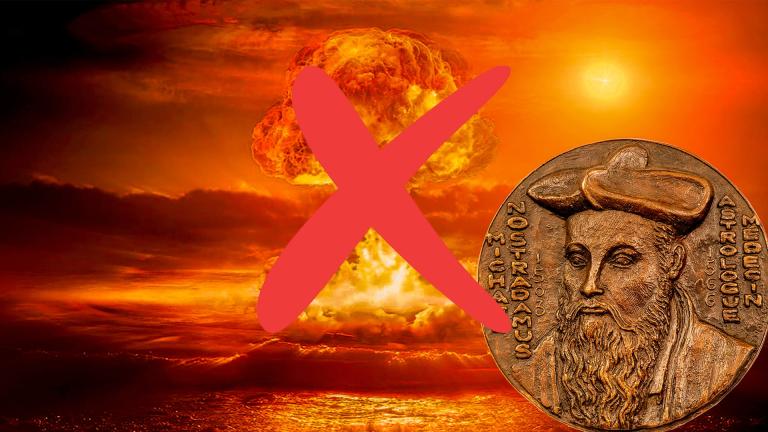
Read more about Mysteries

Every crisis seems to drag Nostradamus back into the headlines. The 16th-century French astrologer wrote in riddling quatrains loaded with wordplay, astrological jargon and deliberate misdirection.
In total he penned 942 poetic, four-line stanzas that allegedly predict future events. More than four centuries later readers have been happy to squeeze modern anxieties into those verses. But for every hit there’s a long trail of claims that simply didn’t happen or rested on readings so elastic they snap on contact with the facts.
Here are some of the biggest misses and misfires we’ve found here at Sky HISTORY:
A favourite verse mentions 'the year ninety-nine and seven month', followed by a 'great king of terror' descending from the sky. By the late 1990s, that became a full-blown end-of-the-world theory. People stocked up on survival kits and some were even convinced an asteroid would end civilisation. July came. July went. Britney Spears had a better month than Armageddon and spent it touring Canada as part of her legendary ...Baby One More Time Tour.
The July anticlimax didn’t stop theories from flying. The 'year ninety-nine and seven month' prediction preceded the much-anticipated millennium. As 2000 approached, the theory folded neatly into fears that the Y2K bug would crash planes, kill power grids and gobble bank accounts. Nostradamus never wrote about computers specifically, but those links were stitched together centuries after his quatrains were written. Just like July, when midnight arrived the lights stayed on, the arrival of the year 2000 was surprisingly uneventful.
Nostradamus famously predicted: 'Mars and the scepter will be in conjunction, A calamitous war under Cancer. A short time afterward a new king will be anointed, Who will bring peace to the earth for a very long time.'
Some astrologers claim that the conjunction of 'Mars and the scepter' refers to an alignment between Jupiter and Mars that took place on 21st June 2002. Of course, no 'calamitous war' unfolded on that day.
You’ll often hear that Nostradamus predicted three Antichrists: Napoleon, Hitler and a third still to come. Over the decades, interpreters have nominated candidates from every continent: Saddam Hussein, Osama Bin Laden, assorted Western leaders...
The actual text itself is vaguer than theorists suggest, and the most famous name, 'Mabus', has been retrofitted to many figures without ever landing cleanly.
Remember the end-of-the-world buzz around the Maya Long Count in 2012 that potentially signified the end of the world? Nostradamus was dragged into that too, usually via TV specials that mashed up his quatrains with Mesoamerican astronomy. He doesn’t mention 2012 and he doesn’t mention the Mayan calendar, but humans love to make associations that aren’t necessarily there. As with Y2K, belief did most of the heavy lifting for this one.
One of the loudest so-called proofs is a verse about 'Hister', presented by fans as Nostradamus naming Hitler centuries early. Except 'Hister' is a period term for the lower Danube. The verse reads like geography, not a reference to a dictator. It’s a tidy demonstration of how Nostradamus’s dense, archaic French can be massaged into a modern headline, if you ignore the dictionary.
From time to time, a Nostradamus line is dusted off to warn of a continent-rending earthquake in a very specific year. Here’s an example of a quatrain interpreted as a great earthquake in the New World (theorists suggest California).
The sloping park, great calamity,
Through the Lands of the West and Lombardy
The fire in the ship, plague and captivity;
Mercury in Sagittarius, Saturn fading.
The catch? Mercury in Sagittarius with Saturn in a 'fading' position was on 25th November 2015. No 'great calamity' hit California (or any other part of the Lands of the West) on that date.
Nostradamus wrote like a man who wanted to be cause confusion. He scrambled names, hinted at dates, folded in classical references and left enough wiggle room to keep the verses evergreen. That plasticity is the point. His quatrains are mirrors. In fearful times, we see what we’re primed to see (think asteroids, mushroom clouds, dictators and natural disasters) then credit the poet for reflecting our worries back at us.
There’s a lesson in the failures. Real history is specific and relies on dates, places, people and causes. Prophecy thrives on vagueness. As far as we’re concerned, there’s one clear winner.
Like this kind of clear-eyed history? Subscribe to the Sky HISTORY newsletter and get more like this straight to your inbox.